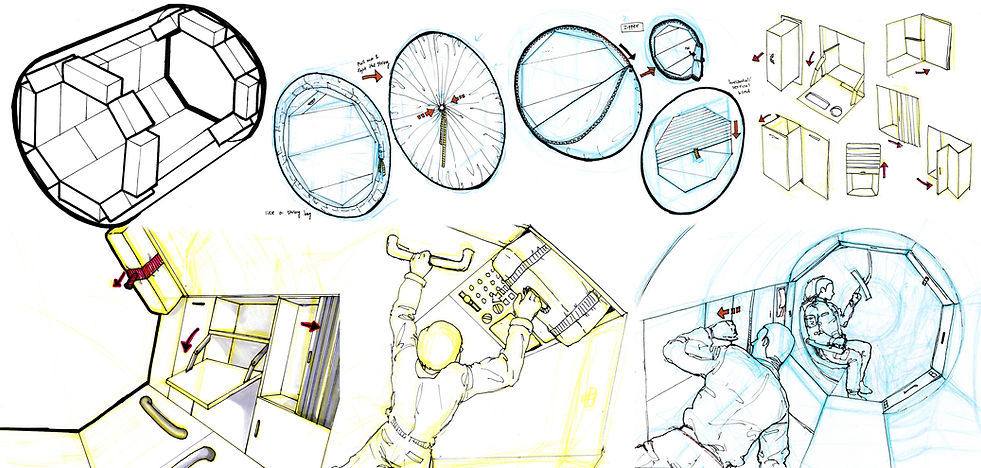







Mars Ascent Vehicle (MAV)
NASA plans to send astronauts to Mars in 2030. I was a part of team of RISD students who collaborated with NASA Johnson Space Center (JSC) to design an interior of a MAV (Mars Ascent Vehicle) concept. We focused on human centric design, specifically, making a safe and comfortable interior for four astronauts.

First Concept Designs
Second Concept Designs
In the beginning, we individually studied and sketched a design concept for the MAV. I focused on the storage and seat position. I sketched storage compartments to be built within the wall that would utilize the round wall space. When I researched other MAV concept designs, many seats were close to each other. I wanted the astronauts to be comfortable and have more space around them. After several sketches, I came up with the diamond shape arrangement (see the above photos), which allows for greater movement.
 |  |  |
|---|---|---|
 |  |  |
 |  |  |
 |  |  |
 |  |  |
 |  |  |
 |  |  |
 |  |  |
Final Presentation
A scale model to show calculated volumes for storage and system requirements for equipment.
Exploration of storage space and interior layout.
After the individual studies, we gathered in groups of 2-3 people to share and improve upon our ideas. We combined our concepts for storage and seating, and created more sketches to refine our ideas. To utilize the round interior of the MAV, we made an octagon shaped structure for storage parts. We calculated the amount of space needed for storage, determined system requirements for equipment, and made a scale model to demonstrate the utilization of the space.
Final Process
Team members: Jihyo Kim, Robert Wang
Team members: Jihyo Kim, Robert Wang, Jeremy Bass, Sungwha Kang,
Minju Kim, Kenta Kondo, Savanna Li, Megan Valanid, Azlee Yu
Team members: Jihyo Kim, Robert Wang, Jeremy Bass, Sungwha Kang,
Minju Kim, Kenta Kondo, Savanna Li, Megan Valanid, Azlee Yu
Based on the second concept design, we began the design process by building a full-scale prototype.
 |  |  |
|---|---|---|
 |  |  |
 |  |  |
 |  |  |
 |  |  |
I primarily worked on the core part of the design: storage and hatches. I calculated the ideal size of the MAV and storage so that astronauts could have enough space to sleep and work. I studied many different arrangements and volumes of storage to find the best solution for utilizing space. I also studied various functionalities of hatches in order to find an ideal shape of hatch that would fit into this MAV.
 |  |  |
|---|---|---|
 |  |  |
 |  |  |
 |  |  |
 |  |  |
 |  |  |
 |  |
 |  |  |
|---|---|---|
 |  |  |
 |  |  |
 |  |  |
After constructing our initial prototype and testing out our ideas, we built our final model of the MAV.